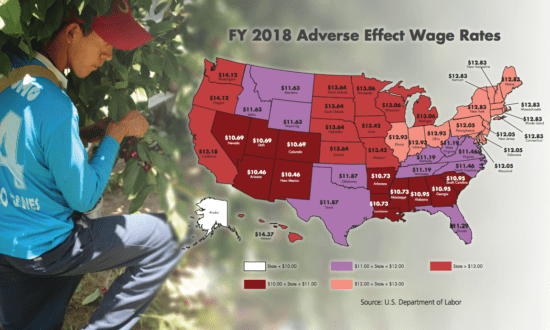

Feb 20, 2018Economist: Farm operators scramble to secure labor
Editor’s note: This is part of a series of stories examining agriculture labor issues in 2018.
The agriculture community is being impacted by the four S’s: satisfy, stretching, substitution and supplementing, according to an agriculture economist who spoke recently in Las Vegas, Nevada, at the fourth annual Ag Employer Forum conducted by the National Council of Agricultural Employers (NCAE).
About 250 forum attendees heard Philip Martin, professor emeritus at UC Davis Agricultural and Resource Economics, outline his belief that farm employers are adjusting to the arrival of fewer unauthorized Mexican newcomers by satisfying current workers, stretching their capabilities with mechanical aids and supplementing their workforces with H-2A guest workers. Longer-term responses include more mechanization, more guest workers and increased imports.
“Most farmers believe that the supply of labor inside U.S. borders is fixed or inelastic, so that higher wages will not attract more farm workers,” Martin said. “Instead, offering benefits and bonuses can help ‘satisfy’ current workers and keep them in the farm workforce longer. Training first-level supervisors can reduce favoritism and harassment.”
Martin said “stretching” workers means increasing their productivity. Most fruits and vegetables are over 90 percent water, and workers spend much of their time carrying harvested produce down ladders to bins or to the end of rows to receive credit for their work. Small trees mean fewer ladders and faster picking, and dwarf trees reduce the need to fill 50- to 60-pound bags of apples or oranges from tall ladders. Slow-moving conveyor belts reduce the need to carry produce, making harvesting jobs more attractive to older workers and women.
“Substitution,” Martin said, is replacing workers with machines. Many fresh fruits and vegetables are fragile, and human hands are gentler than mechanical fingers on grapes or peaches. Machines are fixed costs and workers are variable costs, meaning that farmers must pay for a $200,000 harvesting machine whether there are apples to pick or not, but they do not pay wages if storms or disease destroy the apple crop. Some farmers are switching away from labor-intensive crops, as from raisin grapes to almonds.
“Supplementing” the current workforce with H-2A guest workers means trying and failing to recruit U.S. workers, providing free and approved housing, and paying the Adverse Effect Wage Rate (AEWR), $13.18 an hour in California in 2018 (see accompanying chart). The Department of Labor certified over 200,000 jobs to be filled by H-2A guest workers in 2017, including 15,000 in California.
“There are a million year-round equivalent jobs on U.S. crop farms, and H-2A guest workers may soon fill 20 percent of them,” Martin said.
“The mix of more imports, mechanization and guest workers will be shaped by government policies over the next decade,” Martin said. “NAFTA renegotiations may change regulations on imports and fresh produce. More immigration enforcement could raise labor costs, spurring mechanization where possible and encouraging changes to less labor-intensive crops.
“Reducing employer recruitment and housing obligations and the AEWR could encourage a switch to H-2-A workers,” Martin said. “If guest workers expand to be a third or half of the farm workforce, there could be a return to the Bracero era, when most farmworkers were solo males who lived in camps controlled by the farms where they worked.”
An employer of choice
Michael Saqui has some recommendations for agricultural employers staking their claim for a secure future workforce, regardless of the political climate.
The president of The Saqui Law Group in Roseville, California, spoke at the NCAE Ag Employer Forum. He advocated the pursuit of sustainability through exceptional human relations and safety management.
“Future leaders better start thinking about what it is going to take to be an employer of choice,” Saqui said. “Sustainability is now a big part of this – best practices economics allow you to invest in employees.”
Saqui said high-profile companies are being praised for their work in sustainability and implement exceptional practices and programs through human resources that form that structure.
“Agriculture is trending toward sustainable practices,” he said. “Consumers today want to purchase products from companies they see are treating their employees and communities in ways that are socially responsible. With the proliferation of social media, innovation in this area will be rewarded by increased value in the marketplace.”
Employers should establish and brand as part of their vision best practices that focus on extremely high employee retention rates, highly satisfied employees, high levels of compliance, facility cleanliness, a commitment to safety and transparency.
It’s essential to identify opportunities that engage in issues essential to employees: daycare needs, English as a second language programs, social services liaison, domestic violence counseling and other counseling services, nutrition, health and wellness programs, housing and importance of cultural values.
Ag employers, Saqui said, should solidify their stakeholders, distinguishing those that are real as opposed to perceived.
“Arrive at a shared vision between real stakeholders,” he said. “Be up front about brand separation and profit – don’t make this critical mistake.”
“If you can’t pay your bills or buy fuel necessary to harvest a crop, you don’t have extra income to invest in social and environmental endeavors,” Saqui said.
What are the hot-button issues to achieving and maintaining sustainability compliance in 2018?
Saqui said employers should establish team-driven stakeholders, benchmarks and verification strategies.
“Through continuous improvement, be mindful and intentional,” he said. Expect to cover areas involving water, labor, wages (hours and benefits), employment practices (freedom from discrimination and retaliation), pesticides (management of pests, soils, water, habitat) and food safety (worker hygiene, water use, soil amendments, land use, animals).
Above: Farms participating in the H-2A program must pay workers the Adverse Effect Wage rate for their states. Photo: Gary Pullano














